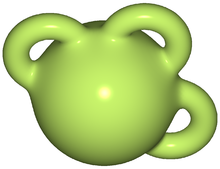Geometric topology

In mathematics, geometric topology is the study of manifolds and maps between them, particularly embeddings of one manifold into another.
History
Geometric topology as an area distinct from
Differences between low-dimensional and high-dimensional topology
Manifolds differ radically in behavior in high and low dimension.
High-dimensional topology refers to manifolds of dimension 5 and above, or in relative terms, embeddings in codimension 3 and above. Low-dimensional topology is concerned with questions in dimensions up to 4, or embeddings in codimension up to 2.
Dimension 4 is special, in that in some respects (topologically), dimension 4 is high-dimensional, while in other respects (differentiably), dimension 4 is low-dimensional; this overlap yields phenomena exceptional to dimension 4, such as
The distinction is because surgery theory works in dimension 5 and above (in fact, in many cases, it works topologically in dimension 4, though this is very involved to prove), and thus the behavior of manifolds in dimension 5 and above may be studied using the surgery theory program. In dimension 4 and below (topologically, in dimension 3 and below), surgery theory does not work. Indeed, one approach to discussing low-dimensional manifolds is to ask "what would surgery theory predict to be true, were it to work?" – and then understand low-dimensional phenomena as deviations from this.
The precise reason for the difference at dimension 5 is because the
A modification of the Whitney trick can work in 4 dimensions, and is called Casson handles – because there are not enough dimensions, a Whitney disk introduces new kinks, which can be resolved by another Whitney disk, leading to a sequence ("tower") of disks. The limit of this tower yields a topological but not differentiable map, hence surgery works topologically but not differentiably in dimension 4.
Important tools in geometric topology
Fundamental group
In all dimensions, the
Orientability
A manifold is orientable if it has a consistent choice of
Handle decompositions

A handle decomposition of an m-manifold M is a union
where each is obtained from by the attaching of -handles. A handle decomposition is to a manifold what a
Local flatness
Suppose a d dimensional manifold N is embedded into an n dimensional manifold M (where d < n). If we say N is locally flat at x if there is a neighborhood of x such that the topological pair is
Schönflies theorems
The generalized
of this theorem.Branches of geometric topology
Low-dimensional topology
Low-dimensional topology includes:
- Surfaces (2-manifolds)
- 3-manifolds
- 4-manifolds
each have their own theory, where there are some connections.
Low-dimensional topology is strongly geometric, as reflected in the uniformization theorem in 2 dimensions – every surface admits a constant curvature metric; geometrically, it has one of 3 possible geometries: positive curvature/spherical, zero curvature/flat, negative curvature/hyperbolic – and the geometrization conjecture (now theorem) in 3 dimensions – every 3-manifold can be cut into pieces, each of which has one of 8 possible geometries.
2-dimensional topology can be studied as complex geometry in one variable (Riemann surfaces are complex curves) – by the uniformization theorem every conformal class of metrics is equivalent to a unique complex one, and 4-dimensional topology can be studied from the point of view of complex geometry in two variables (complex surfaces), though not every 4-manifold admits a complex structure.
Knot theory
Knot theory is the study of mathematical knots. While inspired by knots which appear in daily life in shoelaces and rope, a mathematician's knot differs in that the ends are joined together so that it cannot be undone. In mathematical language, a knot is an embedding of a circle in 3-dimensional Euclidean space, R3 (since we're using topology, a circle isn't bound to the classical geometric concept, but to all of its homeomorphisms). Two mathematical knots are equivalent if one can be transformed into the other via a deformation of R3 upon itself (known as an ambient isotopy); these transformations correspond to manipulations of a knotted string that do not involve cutting the string or passing the string through itself.
To gain further insight, mathematicians have generalized the knot concept in several ways. Knots can be considered in other three-dimensional spaces and objects other than circles can be used; see knot (mathematics). Higher-dimensional knots are n-dimensional spheres in m-dimensional Euclidean space.
High-dimensional geometric topology
In high-dimensional topology,
A
Surgery theory is a collection of techniques used to produce one manifold from another in a 'controlled' way, introduced by Milnor (1961). Surgery refers to cutting out parts of the manifold and replacing it with a part of another manifold, matching up along the cut or boundary. This is closely related to, but not identical with, handlebody decompositions. It is a major tool in the study and classification of manifolds of dimension greater than 3.
More technically, the idea is to start with a well-understood manifold M and perform surgery on it to produce a manifold M ′ having some desired property, in such a way that the effects on the homology, homotopy groups, or other interesting invariants of the manifold are known.
The classification of exotic spheres by Kervaire and Milnor (1963) led to the emergence of surgery theory as a major tool in high-dimensional topology.
See also
References
- ^ "What is geometric topology?". math.meta.stackexchange.com. Retrieved May 30, 2018.
- MR0117695
- MR0117693
- R. B. Sher and ISBN 0-444-82432-4.













